The Buff-bellied Hummingbird (Amazilia yucatanensis) captivates with its enchanting presence and vibrant plumage, earning its place as a cherished member of the hummingbird family.
This medium-sized avian marvel, residing within the expansive Aves class and Trochilidae family, boasts emerald green upper parts complemented by a warm buff-colored belly, a visual symphony that distinguishes it among its kin.
Endowed with a specialized bill and remarkable aerial prowess, Buff-bellied Hummingbirds traverse a diverse range of habitats, from the Yucatan Peninsula in Mexico to the southern United States.
Its alluring appearance, coupled with intricate nesting behaviors and territorial displays, makes it a subject of fascination for bird enthusiasts.
As a species with distinct subspecies, including A. y. yucatanensis, A. y. chalconota, and A. y. cerviniventris, the Buff-bellied Hummingbird invites exploration into the nuanced variations within its population.
In the delicate hum of its wings and the vibrant hues of its plumage, the Buff-bellied Hummingbird stands as a testament to nature’s intricate beauty. Stay focused.
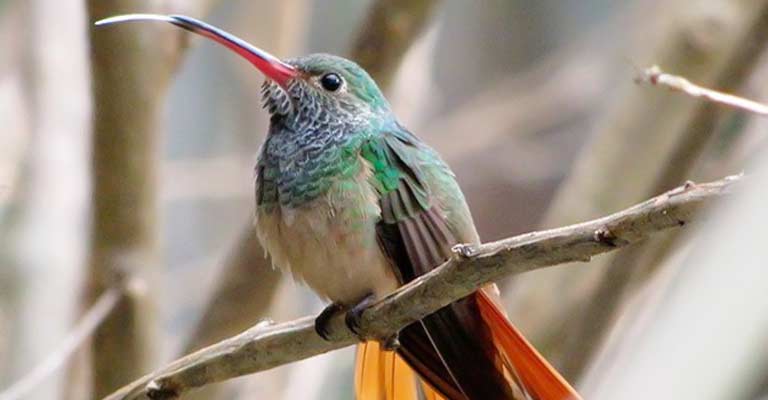
Identifying Characteristics of Buff-bellied Hummingbird
The Buff-bellied Hummingbird (Amazilia yucatanensis) is a captivating species known for its distinctive features, making it relatively easy to identify among other hummingbirds.
Here are some key characteristics that can help you recognize the Buff-bellied Hummingbird:
Size and Shape
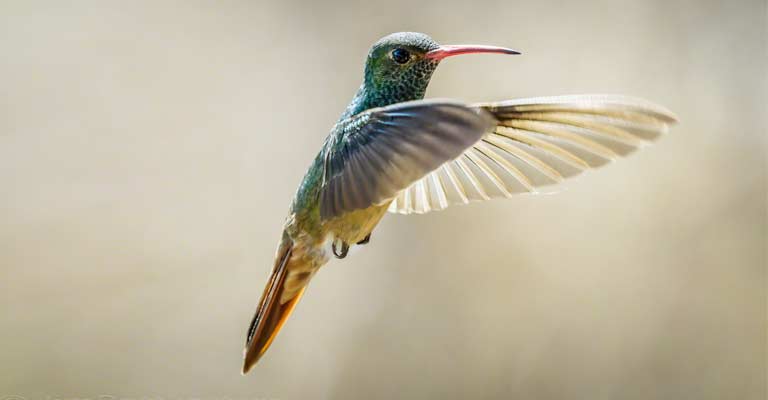
The Buff-bellied Hummingbird is a medium-sized hummingbird, measuring about 3 to 4 inches in length.
It has a slender body with a slightly curved bill. The wings are long and pointed, allowing for agile and swift flight.
Coloration
One of the most prominent features of this hummingbird is its vibrant and iridescent plumage. The upper parts are predominantly green, with a shimmering emerald hue.
The throat exhibits a dazzling iridescence, often displaying shades of metallic green or blue. The underparts, especially the belly, have a warm buff-colored or cinnamon tint, which gives the bird its name.
Head and Facial Markings
Buff-bellied Hummingbirds have a distinctive facial pattern. The crown is usually green, and there may be a noticeable stripe of contrasting color extending from the eye to the back of the head.
The face is adorned with a characteristic white or pale stripe behind the eye.
Tail
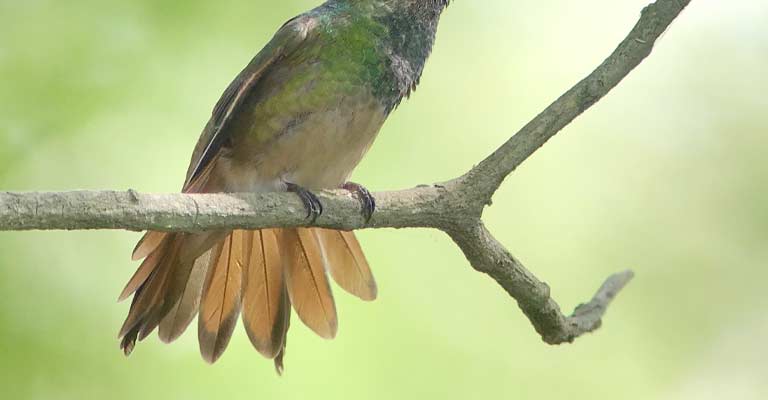
The tail of the Buff-bellied Hummingbird is moderately long and forked. The outer tail feathers often have white tips, creating a distinct pattern when the bird is in flight.
This white-tipped tail is a helpful field mark for identification.
Voice
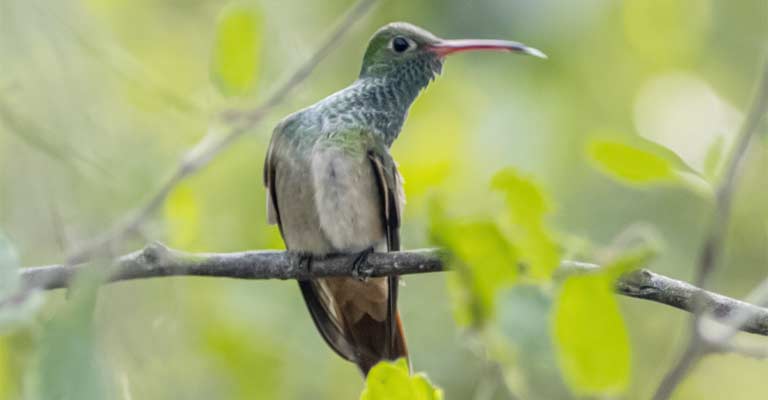
While visual characteristics are crucial for identification, the Buff-bellied Hummingbird also has a distinctive vocalization.
Its call is a series of sharp and high-pitched chips or chirps. Familiarizing yourself with its unique vocalizations can aid in identifying this species.
Habitat
Buff-bellied Hummingbirds are typically found in specific habitats, primarily favoring coastal areas, gardens, and woodlands.
They are known to inhabit regions with tropical and subtropical vegetation, making them more likely to be spotted in these environments.
Range
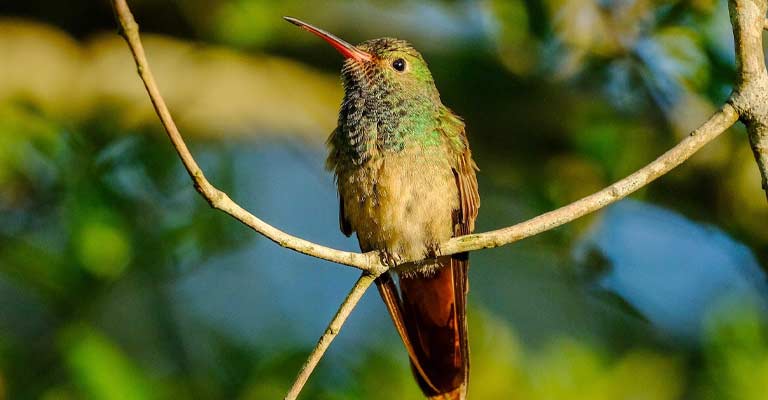
Understanding the geographical range of the Buff-bellied Hummingbird is crucial for identification.
This species is native to Mexico and parts of the southern United States, including Texas and Louisiana. During migration, they may also be found along the Gulf Coast.
Behavior
Observing the behavior of the Buff-bellied Hummingbird can provide additional clues for identification. They are known for their territorial nature and may vigorously defend feeding areas.
Like all hummingbirds, they exhibit rapid and agile flight, often hovering near flowers while feeding.
Recognizing the Buff-bellied Hummingbird involves a combination of visual and auditory cues, understanding its habitat and range, and observing its behavior.
Whether you encounter this captivating hummingbird in your backyard or during a birdwatching expedition, paying attention to these key characteristics will enhance your ability to identify and appreciate this beautiful species.
Taxonomy of Buff-bellied Hummingbird
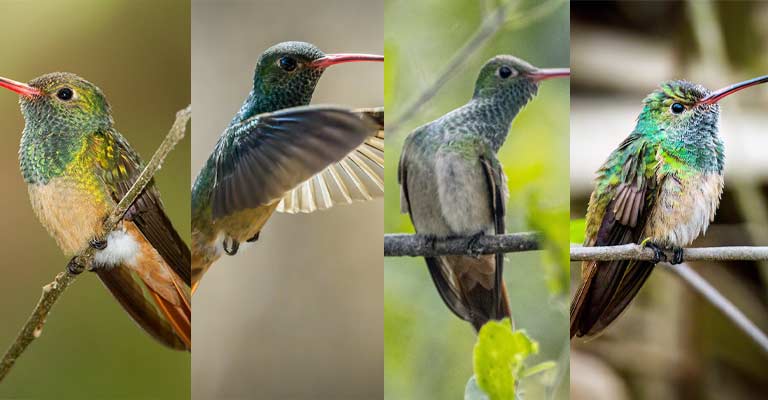
Here’s a table summarizing the taxonomy details of the Buff-bellied Hummingbird:
| Taxonomic Level | Classification |
| Domain | Eukaryota |
| Kingdom | Animalia |
| Phylum | Chordata |
| Class | Aves |
| Clade | Strisores |
| Order | Apodiformes |
| Family | Trochilidae |
| Genus | Amazilia |
| Species | A. yucatanensis |
This table outlines the hierarchical classification of the Buff-bellied Hummingbird, starting from the broad domain level down to the specific species within the genus Amazilia.
This taxonomic information helps categorize and understand the bird in the context of its evolutionary relationships and biological characteristics.
The Buff-bellied Hummingbird (Amazilia yucatanensis) exhibits intriguing variations within its species through three distinct subspecies: the nominate subspecies A. y. yucatanensis, A. y. chalconota, and A. y. cerviniventris.
These subspecies demonstrate subtle differences in their characteristics, contributing to the overall diversity within the Buff-bellied Hummingbird population.
- A. y. yucatanensis (Nominate Subspecies): Found in the Yucatan Peninsula of Mexico. This subspecies typically displays the characteristic emerald green upperparts and buff-colored belly that define the Buff-bellied Hummingbird. Their plumage is vibrant, contributing to their visual allure.
- A. y. chalconota: Inhabits the southern regions of Mexico. While sharing similarities with the nominate subspecies, A. y. chalconota may exhibit slight variations in coloration. The buff-colored belly and iridescent green upperparts remain prominent, reflecting the species’ overall enchanting appearance.
- A. y. cerviniventris: Resides in the southern United States, particularly Texas and Louisiana. Similar to its counterparts, A. y. cerviniventris showcases the iconic emerald green upperparts and distinctive buff-colored belly. Its presence in the United States contributes to the diversity of hummingbird species in the region.
Understanding the variations among these subspecies enhances our appreciation for the nuanced adaptations and distribution of Buff-bellied Hummingbirds.
Each subspecies plays a role in the broader ecological tapestry, showcasing the adaptability of this species across different regions and environments.
Studying these subspecies contributes to a comprehensive understanding of the Buff-bellied Hummingbird’s evolutionary history and ecological significance.
Buff-bellied Hummingbird Life History
The Buff-bellied Hummingbird (Amazilia yucatanensis) is a fascinating species with a rich life history.
From its dietary preferences to nesting habits, breeding behaviors, and conservation status, each aspect provides a glimpse into the intricate life cycle of this charming hummingbird.
Food
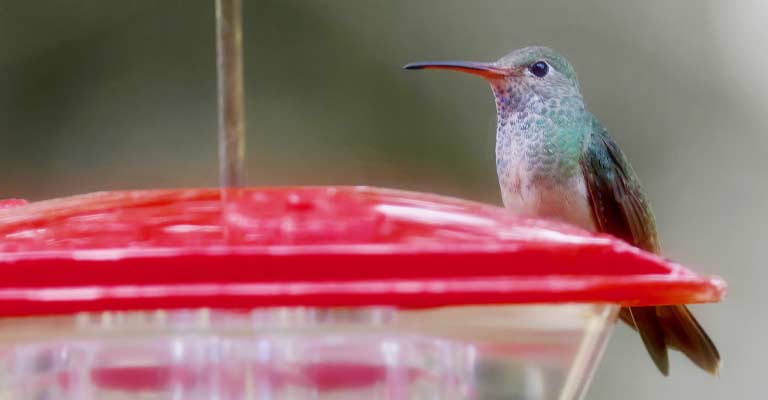
Buff-bellied Hummingbirds primarily feed on nectar from a variety of flowering plants. Their long, specialized bills and extendable, tube-like tongues allow them to extract nectar efficiently.
In addition to nectar, they consume small insects and spiders for protein, supplementing their energy needs. This dual diet is essential for their survival, providing the necessary nutrients for their high metabolism.
Habitat
These hummingbirds are known to inhabit a range of environments, including coastal areas, gardens, and woodlands.
Their preferred habitats feature a mix of tropical and subtropical vegetation, providing an abundance of flowering plants for feeding.
Buff-bellied Hummingbirds are also commonly spotted in urban and suburban areas, showcasing their adaptability to diverse environments.
Range Map
The Buff-bellied Hummingbird’s range extends from Mexico, covering the Yucatan Peninsula, and reaching into the southern United States, particularly Texas and Louisiana.
During migration, their range may expand along the Gulf Coast. Observing a range map is valuable for bird enthusiasts and researchers to understand their distribution and plan effective conservation strategies.
Nesting
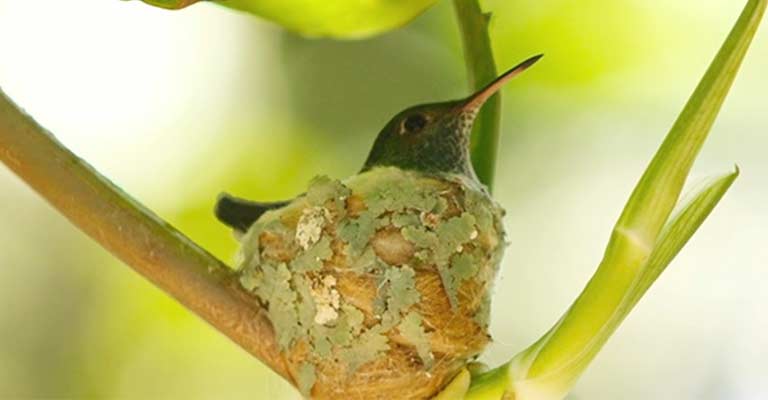
Buff-bellied Hummingbirds construct small, cup-shaped nests using a combination of plant fibers, spider silk, and other soft materials. These nests are typically situated on horizontal branches in trees or shrubs.
The female is solely responsible for nest construction and incubation, highlighting the dedication of these birds to ensuring the survival of their offspring.
Here’s a table summarizing the nesting details of the Buff-bellied Hummingbird:
| Nesting Details of Buff-bellied Hummingbird | Facts |
| Clutch Size | Typically 2 eggs |
| Number of Broods | Often raise 1 brood per season |
| Egg Length | Approximately 0.5 inches (1.3 cm) |
| Egg Width | Around 0.3 inches (0.8 cm) |
| Incubation Period | 15 to 18 days |
| Nestling Period | Approximately 20 days |
| Egg Description | Small, white, and bean-sized |
| Nest Type | Cup-shaped, built on horizontal branches |
| Nest Material | Plant fibers, spider silk, and soft materials |
| Nesting Habitat | Trees or shrubs, often in gardens or woodlands |
These details provide insights into the reproductive characteristics and nesting behaviors of the Buff-bellied Hummingbird, offering a comprehensive view of their breeding cycle.
Breeding
Breeding behavior involves elaborate courtship displays, with males performing aerial acrobatics and vocalizations to attract a mate. After mating, the female lays two white, bean-sized eggs in the carefully crafted nest.
The incubation period lasts about 15 to 18 days, after which the tiny, featherless chicks hatch. The female continues to care for and feed the chicks until they are ready to fledge.
Diseases
Like all wildlife, Buff-bellied Hummingbirds are susceptible to various diseases, including those transmitted by parasites.
Common avian diseases, such as avian pox and hummingbird malaria, can affect their health.
Monitoring for signs of illness, such as lethargy or changes in feeding behavior, is crucial for early detection and intervention.
Treatment
In cases where diseases are identified, prompt intervention is necessary. Treatment may involve veterinary care, including medication or supportive measures.
Maintaining clean and sanitized feeding stations can also contribute to the overall health and well-being of Buff-bellied Hummingbirds, minimizing the risk of disease transmission.
Conservation
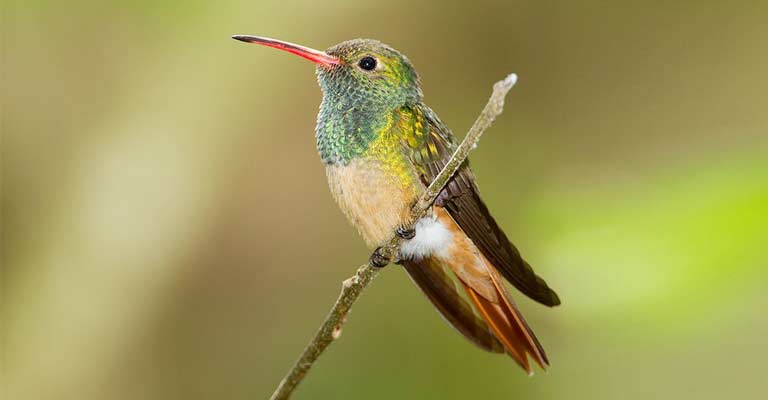
While the Buff-bellied Hummingbird is not currently considered globally threatened, conservation efforts are vital to ensuring their continued well-being.
Preservation of their natural habitats, promotion of native plant species, and responsible birdwatching practices all contribute to the conservation of this species.
Raising awareness about the importance of these practices among the public is instrumental in safeguarding the Buff-bellied Hummingbird and its ecosystem.
The life history of the Buff-bellied Hummingbird is a tapestry woven with intricacies, from its dietary habits and nesting behaviors to breeding rituals and the ongoing efforts to conserve this enchanting species.
Understanding these facets allows us to appreciate the importance of preserving their habitats and working towards a harmonious coexistence with these remarkable birds.
10 Fun Facts About Buff-bellied Hummingbirds
The Buff-bellied Hummingbird (Amazilia yucatanensis) is a delightful and enchanting species with a variety of fascinating traits. Here are 10 fun facts about these charming hummingbirds:
- Vibrant Plumage: The Buff-bellied Hummingbird boasts dazzling plumage, with emerald green upperparts and a distinctive buff-colored belly. The vibrant colors make them a joy to observe, especially when they catch the sunlight.
- Adaptability: These hummingbirds exhibit remarkable adaptability, thriving in a range of environments. From coastal areas and woodlands to gardens and urban spaces, they can be found exploring diverse habitats.
- Unique Range: The Buff-bellied Hummingbird has a unique distribution, primarily found in Mexico, especially the Yucatan Peninsula, and extending into the southern United States, notably Texas and Louisiana. During migration, they may venture along the Gulf Coast.
- Aerial Acrobats: Buff-bellied Hummingbirds are skilled aerial acrobats. During courtship displays, males showcase impressive aerial maneuvers, including rapid dives and loops, to attract potential mates.
- Distinctive Vocalizations: These hummingbirds communicate using sharp and high-pitched vocalizations. The distinct chirps and chips contribute to their unique soundscape, adding to the charm of their presence.
- Feeding Frenzies: Buff-bellied Hummingbirds are known for their territorial behavior around feeding sources. They may engage in feeding frenzies, defending their preferred nectar-rich spots from other hummingbirds and even larger birds.
- Migratory Marvels: While some populations of Buff-bellied Hummingbirds are year-round residents, others undertake seasonal migrations. Understanding their migratory patterns adds an extra layer of intrigue to their life history.
- Tiny Eggs: The eggs of Buff-bellied Hummingbirds are incredibly small, measuring about half an inch in length. These tiny, white eggs are a testament to the delicate nature of these remarkable birds’ reproductive process.
- Nest Craftsmanship: Female Buff-bellied Hummingbirds are skilled nest builders. They create cup-shaped nests using plant fibers, spider silk, and soft materials, often situated on horizontal branches in trees or shrubs.
- Sweet Tooth for Nectar: Buff-bellied Hummingbirds have a sweet tooth for nectar, which they obtain from a variety of flowering plants. Their long, specialized bills and extendable tongues allow them to access the sugary reward within the flowers.
The Buff-bellied Hummingbird is not just a visual delight but also a species with captivating behaviors and characteristics.
Whether they dazzle us with their vibrant colors, showcasing aerial acrobatics, or engaging in territorial antics, these hummingbirds never fail to bring joy to bird enthusiasts and nature lovers alike.
Wrapping Up
In the realm of avian wonders, the Buff-bellied Hummingbird stands out with its vibrant plumage, aerial acrobatics, and unique adaptability.
From their distinctive vocalizations to the delicate craftsmanship of their nests, these hummingbirds weave a tapestry of fascination.
Whether observed in gardens, woodlands, or coastal areas, the Buff-bellied Hummingbird leaves an indelible mark on the hearts of bird enthusiasts, emphasizing the importance of understanding and preserving their diverse habitats. Thank you so much.